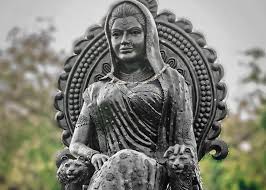Who Was Rani Kamalapati? Story of Valor and Resilience
Indian history is filled with remarkable queens who left behind legacies of strength, sacrifice, and resilience. Among them stands Rani Kamlapati, a queen from the Gond dynasty in Central India, whose courage continues to inspire generations. Her story is not just about royalty but also about determination and bravery during a time of political unrest and personal tragedy. She played a crucial role in the history of Bhopal and remains a symbol of feminine power and resilience.
Early Life and Background
Rani Kamlapati belonged to the Gond dynasty, one of the prominent tribal kingdoms of Central India. Known for their cultural richness and administrative wisdom, the Gonds ruled vast areas of present-day Madhya Pradesh. She was married to Nizam Shah, the Gond ruler of Ginnorgarh Fort, a strategically important fortress in Bhopal. Her life took a dramatic turn after the untimely death of her husband, which brought challenges that tested her courage and strength.
The Tragedy of Nizam Shah’s Death
The assassination of her husband Nizam Shah by treachery was a turning point in Rani Kamlapati’s life. Betrayal by close relatives and the looming threat of external invasions left the kingdom vulnerable. In the face of such devastation, the queen refused to succumb to despair. Instead, she chose to stand firm and protect her people, demonstrating remarkable leadership qualities. Her resolve in this moment of crisis is what transformed her into a historical figure of courage and endurance.
Her Leadership and Struggle
After Nizam Shah’s death, Rani Kamlapati assumed leadership of Ginnorgarh. Despite being surrounded by political instability and constant threats from rival rulers, she worked tirelessly to safeguard her kingdom. She fortified her territory, strengthened alliances, and displayed great resilience in the face of adversities. Her decisions reflected a blend of strategic thinking and emotional strength, qualities that set her apart as a leader.
Legacy in Bhopal’s History
Rani Kamalapati’s story is not only about her personal struggles but also about her significant contribution to shaping Bhopal’s history. She is often remembered as a protector of her people, a symbol of honor, and a leader who prioritized the well-being of her subjects over her own comfort. Her legacy is preserved in monuments, folk tales, and historical accounts that celebrate her resilience and bravery.
Rani Kamlapati’s Palace
One of the lasting symbols of her reign is the Kamlapati Palace in Bhopal. Situated near the Upper Lake, this architectural marvel reflects the grandeur of Gond royalty and serves as a reminder of her life and times. Today, the palace stands as a heritage site, attracting historians and tourists who wish to connect with the legacy of the brave queen.
Symbol of Valor and Resilience
The queen’s life represents the struggle of women in history who rose above personal grief to defend their kingdoms and values. She embodies resilience, a quality that continues to inspire women today. In honoring her story, we also recognize the countless women who, like her, have faced adversity with strength and determination.
Conclusion
So, who was Rani Kamlapati? She was more than a queen; she was a leader, a warrior, and a symbol of unwavering courage. Her story of valor and resilience is a reminder that true strength lies not in power alone but in the ability to rise above challenges and protect what one values most. Her name continues to live on in the cultural and historical fabric of Bhopal, serving as an enduring source of inspiration.



Leave a Reply
Want to join the discussion?Feel free to contribute!